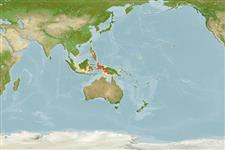>
Eupercaria/misc (Various families in series Eupercaria) >
Labridae (Wrasses)
Etymology: Paracheilinus: Greek, para = the side of + Greek, chaite = hair + Greek, odous = teeth (Ref. 45335); nursalim: Named for Sjamsul and Itjih Nursalim; noun in apposition..
Environment: milieu / climate zone / depth range / distribution range
ນິເວດວິທະຍາ
ສັດທະເລ ກ່ຽວກັນຫີນ; ລະດັບຄວາມເລິກ 5 - 50 m (Ref. 74967), usually 20 - 35 m (Ref. 74967). Tropical
Western Pacific: New Guinea, Indonesia.
ຂະໜາດ / ນ້ຳໜັກ / Age
Maturity: Lm ? range ? - ? cm
Max length : 5.1 cm SL ຕົວຜູ້/ບໍ່ມີເພດ; (Ref. 74967); 2.9 cm SL (female)
Short description
ສະລີລະວິທະຍາ | ການວັດແທກຮູບຮ່າງລັກສະນະພາຍນອກຂອງດິນ,ສັດ,ປາ…
ຄີ (ໜາມ)ແຂງຢູ່ຫຼັງປາ (ທັງໝົດ): 8 - 9; ຄີຫຼັງຂອງປາ (ຄີອ່ອນ) (ທັງໝົດ): 11; ຄີ(ໜາມ) ແຂງຢູ່ຄີກົ້ນປາ
ກຸ່ມປາກະດູກແຂງ
ຄວາມຖີ່ຂອງກຸ່ມຖ່າຍທອດພັນ
ປາທີ່ມີການເຄື່ອນຍ້າຍຈາກທະເລໄປຫານ້ຳຈືດ ແລະນ້ຳຈືດຫາທະເລ
ປາທີ່ມີການເຄື່ອນຍ້າຍຈາກທະເລແລະໄປໄຂ່ຢູ່ນ້ຳຈືດ
ຄີກົ້ນຂອງປາ
ສັດທີ່ມີກະດູກສັນຫັຼງ
ການຖ່າຍທອດທາງກຳມະພັນຈາກພໍ່ແມ່ຫາລູກ 3; ຄີກົ້ນຂອງປາ: 8 - 10. This species is distinguished by the following set of characters: pored lateral-line scales 11-16+3-10, often 16+5-7; gill rakers usually 12-13 (sometimes 14-15); body depth 2.9-3.5 in SL; often, 4-6 (rarely 3) dorsal soft rays of males prolonged as narrow, tapering filaments that are erected during courtship; in males, caudal fin strongly lunate, the length 1.6 (1.7-2.4) in SL and caudal concavity 0.8-1.5 in HL; pelvic fins 1.6-1.8 in males and 2.0-2.2 in females, both in HL; live colour of male differs from all other Paracheilinus in having a pair of rectangular blackish patches, one on ventral half of caudal peduncle and adjacent body, and the other, often less distinct, on upper back, below middle of spinous dorsal fin. Similar to P. cyaneus in general appearance; sympatric throughout its known range (Misool, Fak Fak Peninsula, and Triton Bay area). The two species are easily distinguished on the basis of male coloration, particularly that associated with courtship displays (Ref. 74967).
Inhabits semi-sheltered areas, exposed to periodic strong currents; invariably associated with gradual rubble slopes at depths ranging from about 5-50 m or more, but most abundant between about 20 and 35 m. Large aggregations, of about 30 males and several hundred females, were occasionally encountered in only 6 to 10 m at Triton Bay (Ref. 74967).
Life cycle and mating behavior
ການຈະເລີນເຕັມໄວ | ການສືບພັນ | ການວາງໄຂ່ | ໄຂ່ | ຄວາມດົກຂອງໄຂ່ປາ | ຕົວອ່ອນ
Oviparous, distinct pairing during breeding (Ref. 205).
Allen, G.R. and M.W. Erdmann, 2008. Paracheilinus nursalim, a new species of flasher wrasse (Perciformes: Labridae) from the Bird's Head Peninsula of western New Guinea with a key to the species of Paracheilinus,. aqua, Int. J. Ichthyol. 13(3-4):179-188. (Ref. 74967)
IUCN Red List Status (Ref. 130435)
Threat to humans
Harmless
Human uses
ຂໍ້ມູນຕື່ມອີກ
ຊື່ສາມັນຄຳສັບຄ້າຍຄືກັນການເຜົາໃໝ້ພະລັງງານໂດຍປ່ຽນທາດອາຫານໃນຮ່າງກາຍໃຫ້ກາຍເປັນຊີ້ນແລະໜັງຜູ້ລ້າການສຶກສາຜົນກະທົບຂອງສານຜິດທີ່ມີຜົນກະທົບຕໍ່ລະບົບນິເວດການສືບພັນການຈະເລີນເຕັມໄວການວາງໄຂ່ການສັງລວມການວາງໄຂ່ຄວາມດົກຂອງໄຂ່ປາໄຂ່Egg development
Age/Sizeການເຕີບໃຫຍ່Length-weightLength-lengthLength-frequenciesການວັດແທກຮູບຮ່າງລັກສະນະພາຍນອກຂອງດິນ,ສັດ,ປາ…ສະລີລະວິທະຍາຕົວອ່ອນການປ່ຽນແປງຂອງຕົວອ່ອນການທົດແທນທີ່ຄວາມອຸດົມສົມບູນBRUVS
ເອກະສານອ້າງອີງການລ້ຽງສັດນ້ຳຂໍ້ມູນການລ້ຽງສັດນ້ຳສາຍພັນກຳມະພັນElectrophoresesການຖ່າຍທອດທາງກຳມະພັນຈາກພໍ່ແມ່ຫາລູກພະຍາດການປຸງແຕ່ງNutrientsMass conversion
ຜູ້ຮ່ວມມືຮູບStamps, Coins Misc.ສຽງຫອຍມີພິດຊະນິດນຶ່ງທີ່ອາໄສໃນທະເລຄວາມໄວປະເພດການລອຍເນື້ອທີ່ເຫືອກOtolithsສະໝອງວິໄສທັດ
ເຄື່ອງມື
Special reports
Download XML
ແຫຼ່ງອີນເຕີເນັດ
Estimates based on models
Preferred temperature (Ref.
123201): 27.9 - 29, mean 28.3 °C (based on 32 cells).
Phylogenetic diversity index (Ref.
82804): PD
50 = 0.5000 [Uniqueness, from 0.5 = low to 2.0 = high].
Bayesian length-weight: a=0.00955 (0.00456 - 0.02002), b=3.06 (2.89 - 3.23), in cm total length, based on LWR estimates for this (Sub)family-body shape (Ref.
93245).
ຊັ້ນເຂດຮ້ອນ (Ref.
69278): 3.3 ±0.4 se; based on size and trophs of closest relatives
ຄວາມຢືດຢຸ່ນ (Ref.
120179): ສູງ, ປະຊາກອນຕຳ່ສຸດທີ່ໃຊ້ເວລາສອງໜ້ອຍກວ່າ 15 ເດືອນ (Preliminary K or Fecundity.).
Fishing Vulnerability (Ref.
59153): Low vulnerability (10 of 100).
Nutrients (Ref.
124155): Calcium = 181 [102, 412] mg/100g; Iron = 1.21 [0.66, 2.41] mg/100g; Protein = 18.1 [15.1, 20.3] %; Omega3 = 0.192 [0.099, 0.360] g/100g; Selenium = 24.2 [11.5, 51.5] μg/100g; VitaminA = 293 [85, 1,131] μg/100g; Zinc = 2.39 [1.48, 3.85] mg/100g (wet weight);
